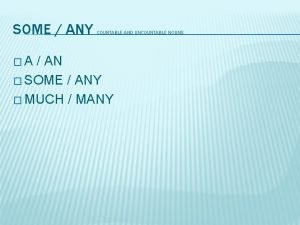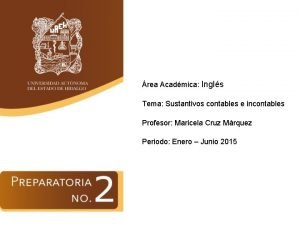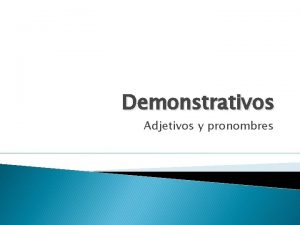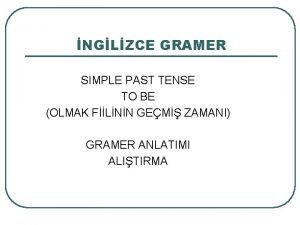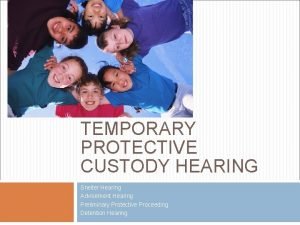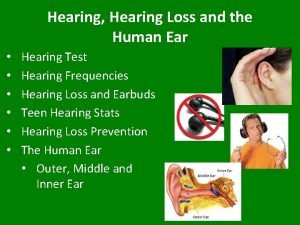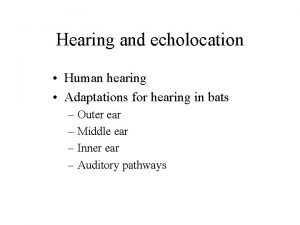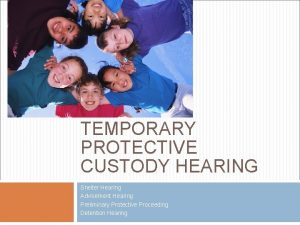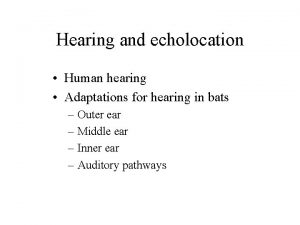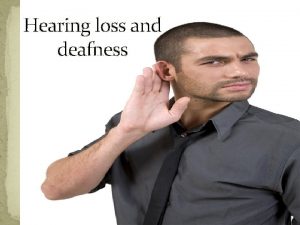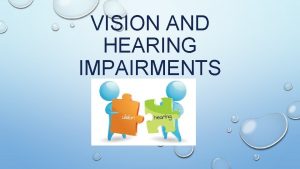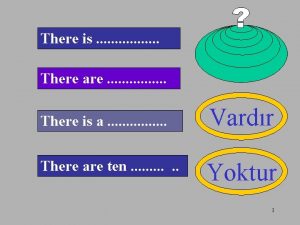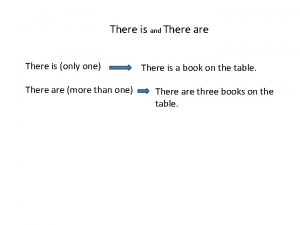Testing the Hearing Testing the Hearing There are





















- Slides: 21

Testing the Hearing

Testing the Hearing There are three stages to testing the hearing and all are important. Audiograms can be wrong. 1 Clinical assessment of the degree of deafness. 2 Tuning fork tests. 3 Audiometry.

CLINICAL ASSESSMENT OF THE DEGREE OF DEAFNESS – By talking to the patient, the examiner quickly appreciates how well a – patient can hear and this assessment continues throughout the interview. – A more formal assessment is then made by asking the patient to repeat – words spoken by the examiner at different intensities and distances in each – ear in turn. The result is recorded as, for example, whispered voice (WV) – at 150 cm in a patient with slight deafness, or conversational voice (CV) at – 15 cm in a deafer individual. – If profound unilateral deafness is suspected, the good ear should be – masked with a Barany noise box and the deaf ear tested by shouting into it. – The limitations of voice and whisper tests must be borne in mind; they – are approximations but with practice can be a good guide to the level of – hearing and will confirm the audiometric findings.

TUNING FORK TESTS Before considering tuning fork tests it is necessary to have a basic concept of classification of deafness. Almost every form of deafness (and there are many) may be classified under one of these headings: • conductive deafness; • sensorineural deafness; • mixed conductive and sensorineural deafness. – Conductive deafness (Fig. 3. 1) Conductive deafness results from mechanical attenuation of the sound waves in the outer or middle ear, preventing sound energy from reaching the cochlear fluids. It may be remediable by surgery and so it is important it is recognized. The hearing by bone conduction will be normal in pure conductive deafness.

Conductive deafness

Sensorineural deafness results from defective function of the cochlea or of the auditory nerve, and prevents neural impulses from being transmitted to the auditory cortex of the brain. – Mixed deafness is the term used to describe a combination of conductive and sensorineural deafness in the same ear.

Sensorineural deafness – RINNE’S TEST This test compares the relative effectiveness of sound transmission through the middle ear by air conduction (AC), and bypassing the middle ear by bone conduction (BC). It is usually performed as follows: a tuning fork of 512 Hz (cycles per second) is struck and held close to the patient’s ear; it is then placed firmly on the mastoid process and the patient is asked to state whether it is heard better by BC or AC.

RINNE’S TEST

WEBER’S TEST This test is useful in determining the type of deafness a patient may have and in deciding which ear has the better-functioning cochlea. The base of a vibrating tuning fork is held on the vertex of the head and the patient is asked whether the sound is heard centrally or is referred to one or other ear. In conductive deafness the sound is heard in the deafer ear. In sensorineural deafness the sound is heard in the better-hearing ear (Figs 3. 3– 3. 5)

WEBER’S TEST

AUDIOMETRY PURE TONE AUDIOMETRY Pure tone audiometry provides a measurement of hearing levels by AC and BC and depends on the cooperation of the subject. The test should be carried out in a sound-proofed room. The audiometer is an instrument that generates pure tone signals ranging from 125 to 12 000 Hz (12 k. Hz) at variable intensities. The signal is fed to the patient through ear phones (for AC)or a small vibrator applied to the mastoid process (for BC). Signals of increasing intensity at each frequency are fed to the patient, who indicates when the test tone can be heard. The threshold of hearing at each frequency is charted in the form of an audiogram (Figs 3. 6– 3. 8), with hearing loss expressed in decibels (d. B). Decibels are logarithmic units of relative intensity of sound energy. When testing hearing by BC, it is essential to mask the opposite ear with narrow-band noise to avoid crosstransmission of the signal to the other ear.

AUDIOMETRY

SPEECH AUDIOMETRY Speech audiometry is employed to measure the ability of each ear to discriminate the spoken word at different intensities. A recorded word list is supplied to the patient through the audiometer at increasing loudness levels, and the score is plotted on a graph. In some disorders, the intelligibility of speech may fall off above a certain intensity level. It usually implies the presence of loudness recruitment—an abnormal growth of loudness perception. Above a critical threshold, sounds are suddenly perceived as having become excessively loud. This is indicative of cochlear disorder.

IMPEDANCE TYMPANOMETRY Impedance tympanometry measures not hearing but, indirectly, the compliance of the middle-ear structures. A pure tone signal of known intensity is fed into the external auditory canal and a microphone in the ear probe measures reflected sound levels. Thus, the sound admitted to the ear can be measured. Most sound is absorbed when the compliance is maximal, and, by altering the pressure in the external canal, a measure can be made of the compliance at different pressures. Impedance testing is widely used as a screening method for otitis media with effusion (OME) in children. If there is fluid in the middle ear, the compliance curve is flattened.

IMPEDANCE TYMPANOMETRY

IMPEDANCE TYMPANOMETRY

IMPEDANCE TYMPANOMETRY

ELECTRIC RESPONSE AUDIOMETRY Electric response audiometry is a collective term for various investigations whereby action potentials at various points within the long and complex auditory pathway can be recorded. The action potential (AP) is evoked by a sound stimulus applied to the ear either through headphones or free field, and the resulting AP is collected in a computer store. Although each AP is tiny, it occurs at the same time interval after the stimulus (usually a click of very short duration) and so a train of stimuli will produce an easily detectable response, while the averaging ability of the computer will average out the more random electrical activity, such as the EEG. By making the computer look at different time windows, responses at various sites in the auditory pathway can be investigated. As the response travels from the cochlea to the auditory cortex, the latency increases from about 1 -4 to 300 ms.

ELECTRIC RESPONSE AUDIOMETRY

ELECTRIC RESPONSE AUDIOMETRY There are three main responses used in clinical audiology. 1 Electrocochleogram (E Coch G), which is recorded from an electrode inserted through the ear drum onto the promontory and can be recorded under anaesthetic. 2 Brain-stem responses, recorded from external electrodes (BSER). 3 Slow vertex or cortical responses, again recorded from external electrodes (SVR or CERA). Electric response audiometry has the unique advantage of being an objective measure of hearing requiring no cooperation from the subject. It is of value in assessing hearing thresholds in babies and small children and in cases of dispute such as litigation for industrial deafness.

Oto-acoustic emissions (OAE) When the cochlea is subjected to a sound wave it is stimulated to produce itself an emission of sound generated within the cochlea. This can be detected and recorded and has been used as a screening test of hearing in newborn babies. It is now in routine clinical use in testing those babies who are particularly at risk of hearing problems, such as premature or hypoxic neonates, and is likely to play a part in universal screening for hearing loss.
 Insidan region jh
Insidan region jh Some any an a правило
Some any an a правило What part of speech is open
What part of speech is open Let's practice the game
Let's practice the game There is there are
There is there are El ketchup es contable o incontable
El ketchup es contable o incontable There is there are negative form
There is there are negative form Hay is
Hay is There is there are
There is there are The committee debates these questions carefully
The committee debates these questions carefully Pep unit
Pep unit There are there is
There are there is There's and there are
There's and there are Adjetivos demonstrativos
Adjetivos demonstrativos There is there are ejemplos
There is there are ejemplos Ingilizce gramer zamanlar tablosu
Ingilizce gramer zamanlar tablosu There isn't any
There isn't any If there is no struggle there is no progress examples
If there is no struggle there is no progress examples Decision table testing
Decision table testing Decision tables testing
Decision tables testing Positive testing and negative testing
Positive testing and negative testing Software domain examples
Software domain examples

